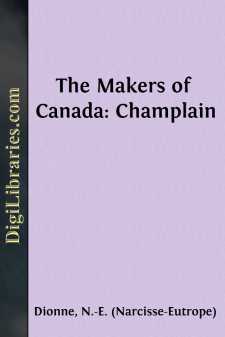Categories
- Antiques & Collectibles 13
- Architecture 36
- Art 48
- Bibles 22
- Biography & Autobiography 813
- Body, Mind & Spirit 142
- Business & Economics 28
- Children's Books 17
- Children's Fiction 14
- Computers 4
- Cooking 94
- Crafts & Hobbies 4
- Drama 346
- Education 46
- Family & Relationships 57
- Fiction 11829
- Games 19
- Gardening 17
- Health & Fitness 34
- History 1377
- House & Home 1
- Humor 147
- Juvenile Fiction 1873
- Juvenile Nonfiction 202
- Language Arts & Disciplines 88
- Law 16
- Literary Collections 686
- Literary Criticism 179
- Mathematics 13
- Medical 41
- Music 40
- Nature 179
- Non-Classifiable 1768
- Performing Arts 7
- Periodicals 1453
- Philosophy 64
- Photography 2
- Poetry 896
- Political Science 203
- Psychology 42
- Reference 154
- Religion 513
- Science 126
- Self-Help 84
- Social Science 81
- Sports & Recreation 34
- Study Aids 3
- Technology & Engineering 59
- Transportation 23
- Travel 463
- True Crime 29
The Makers of Canada: Champlain
Description:
Excerpt
CHAPTER I
CHAMPLAIN'S FIRST VOYAGE TO AMERICA
Samuel Champlain, the issue of the marriage of Antoine Champlain and Marguerite Le Roy, was born at Brouage, now Hiers Brouage, a small village in the province of Saintonge, France, in the year 1570, or according to the Biographie Saintongeoise in 1567. His parents belonged to the Catholic religion, as their first names would seem to indicate.
When quite young Samuel Champlain was entrusted to the care of the parish priest, who imparted to him the elements of education and instilled his mind with religious principles. His youth appears to have glided quietly away, spent for the most part with his family, and in assisting his father, who was a mariner, in his wanderings upon the sea. The knowledge thus obtained was of great service to him, for after a while he became not only conversant with the life of a mariner, but also with the science of geography and of astronomy. When Samuel Champlain was about twenty years of age, he tendered his services to Marshal d'Aumont, one of the chief commanders of the Catholic army in its expedition against the Huguenots.
When the League had done its work and the army was disbanded in 1598, Champlain returned to Brouage, and sought a favourable opportunity to advance his fortune in a manner more agreeable, if possible, to his tastes, and more compatible with his abilities. In the meantime Champlain did not remain idle, for he resolved to find the means of making a voyage to Spain in order "to acquire and cultivate acquaintance, and make a true report to His Majesty (Henry IV) of the particularities which could not be known to any Frenchmen, for the reason that they have not free access there." He left Blavet at the beginning of the month of August, and ten days after he arrived near Cape Finisterre. Having remained for six days at the Isle of Bayona, in Galicia, he proceeded towards San Lucar de Barameda, which is at the mouth of the river Seville, where he remained for three months. During this time he went to Seville and made surveys of the place. While Champlain was at Seville, a patache, or advice boat, arrived from Porto Rico bearing a communication addressed to the king of Spain, informing him that a portion of the English army had put out to sea with the intention of attacking Porto Rico.
The king fitted out twenty ships to oppose the English, one of which, the Saint Julien, was commanded by Provençal, Champlain's uncle. Champlain proposed to join the expedition under his uncle, but Provençal was ordered elsewhere, and General Soubriago offered the command of the Saint Julien to Champlain, which he gladly accepted.
The armada set sail in the beginning of January, 1599, and within six days, favoured by a fresh breeze, the vessels sighted the Canary Islands. Two months and six days later the armada drew near to the island called La Désirade, which is the first island approached in this passage to the Indies. The ships anchored for the first time at Nacou, which is one of the finest ports of the Guadeloupe. After having passed Marguerite Island and the Virgins, Champlain proceeded to San Juan de Porto Rico, where he found that both the town and the castle or fortress had been abandoned, and that the merchants had either made their escape or had been taken prisoners. The English army had left the town and had taken the Spanish governor with them, as he had surrendered on the condition that his life should be spared.
On leaving Porto Rico the general divided the galleons into three squadrons, and retained four vessels under his own command. Three were sent to Porto Bello, and three, including Champlain's vessel, to New Spain. Champlain arrived at Saint Jean de Luz eight days afterwards, although the place is fully four hundred leagues from Porto Rico. This fortress bore the name of San Juan d'Ulloa. Fifteen days afterwards we find Champlain setting sail for Mexico, situated at a distance of over one hundred leagues from San Juan.
Champlain was evidently very much interested in this country, and his description is that of an enthusiast: "It is impossible to see or desire a more beautiful country than this kingdom of New Spain, which is three hundred leagues in length, and two hundred in breadth.......


